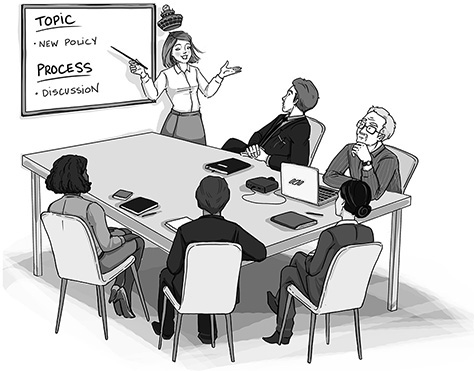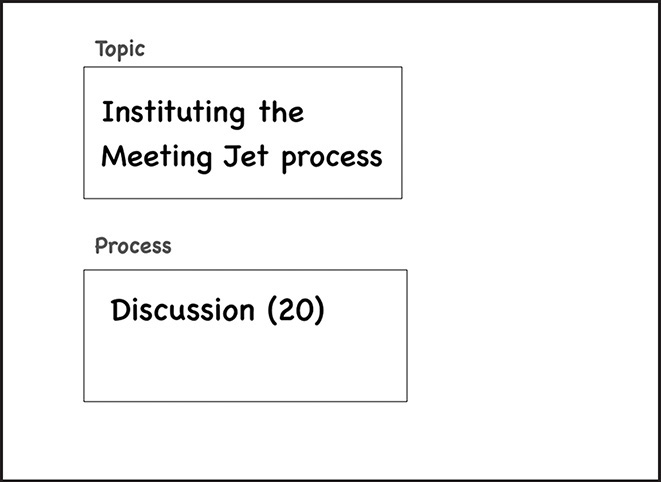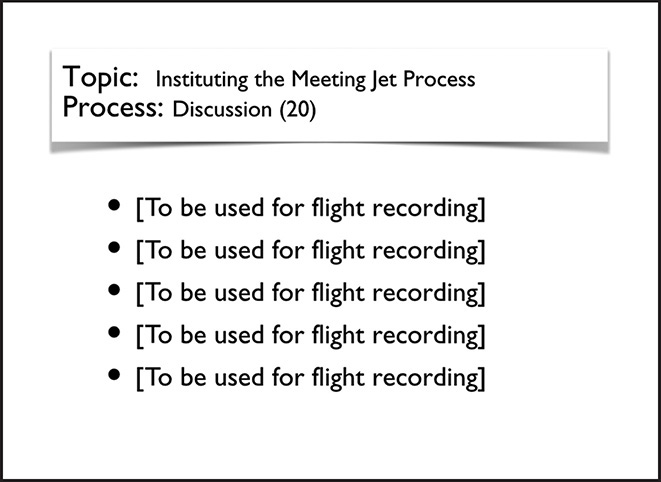7
![]()
Staying on Course with Air Traffic Control

To map out a course of action and follow it to an end requires courage.
—RALPH WALDO EMERSON
CREATING FOCUS AT THE MEETING
To bring a group of people into Holographic Thinking requires focus. Successful focus begins in the preparation stage to make sure each agenda item has a purpose and “What do you need from me.” Think of these two parts of each agenda item as critical lenses that must be in place. At the meeting we will add additional lenses to make sure that everyone is focused:
• On the same subject
• At the same time
• In the same way
• Using the same process
CREATING FOCUS WITH VISUAL DEVICES
Using visual devices is another important way to keep people focused and facilitate Holographic Thinking. A visual device is something everyone at the meeting can see. Examples are a whiteboard, flip chart, or computer connected to a monitor or projector. Some visual devices are erasable whereas others are not—that is, a whiteboard is erasable and a flip chart is not. Both erasable and nonerasable visual devices have their place in the Meeting Jet process.
For the purpose of maintaining everyone’s focus on the same topic, at the same time, with the same process, an erasable visual device is best. On your erasable visual device, create a topic box and a process box. Maintaining the group’s focus on the topic and process is the responsibility of the Air Traffic Controller.
In virtual meetings, it is important to make sure that everyone understands the importance of being able to see a screen and not just call in using audio. If they can’t see the screen, you can assume that they are not completely focused, could be multitasking, or are in an inopportune environment to fully participate. (We will cover all this in detail in Chapter 12 on virtual meetings.)
The Topic Box
In a face-to-face meeting, I find a whiteboard useful for creating a focus on the topic and process. I draw a topic box and a process box on the left side. In virtual as well as face-to-face meetings, a simple PowerPoint slide works well too. Put the topic and process in the title area of the slide. The bullets area will be used for flight recording, which we will discuss later.
Write whatever topic is on the floor at the moment in the topic box and whatever process the group is using in the process box. When the topic changes, the Air Traffic Controller updates the topic box. Sometimes you might add a subtopic. If you are discussing the value of instituting the Meeting Jet process in your organization, then write, “The value of instituting the Meeting Jet process” in the topic box. Perhaps at a later point in the agenda, the focus of your discussion might become more specific as in, “The value of instituting the Meeting Jet process by having Dr. Brinkman train our trainers.” Make sure the topic box reflects what the group should be focused on at any particular moment if the meeting is to stay on course.
The Process Box
In the process box, the Air Traffic Controller writes the process being used in relation to the topic. For example, is the group brainstorming, or are they discussing? (More on the types of processes later.) Next to each process should be a number representing the minutes the group will focus on that topic using that specific process.
Let’s say an agenda item began with a 10-minute presentation about the state of meetings in the company. Then there is a 5-minute Q&A, followed by a 20-minute discussion of the value of instituting the Meeting Jet process, and then a 10-minute subtopic of analyzing the positives and negatives of having Dr. Brinkman train their trainers. Then attendees would take a 5-minute vote on a decision whether to do it.
So in the process box, over the course of 50 minutes, we would have the following: first Presentation, 10 minutes; then Q&A, 5 minutes; then Discussion, 20 minutes; then Positives (matching), then Negatives (mismatching), 10 minutes; and finally, Decision by voting, 5 minutes. Only one process is in the process box at any given time. This keeps people focused on the same process at the same time (Figures 7.1 and 7.2).

FIGURE 7.1 Air Traffic Control Topic and Process Boxes on a Whiteboard

FIGURE 7.2 Air Traffic Control Topic and Process Boxes on a PowerPoint Slide for Virtual Meetings (or Face-to-Face)
In addition to the topic and process boxes, the flight plan (agenda) that attendees should have in front of them would show them the big picture of what they are doing and how to do it with purpose and “What do you need from me.”
• #1 Agenda item: Instituting Meeting Jet process
• Time: 10:03 to 10:53 a.m. (50 minutes)
• Who: Geoff
• Purpose: To consider if we can save time and get more done by implementing a departmentwide policy on how to run meetings
• Process with times:
![]() Presentation, 10 minutes (Geoff)
Presentation, 10 minutes (Geoff)
![]() Q&A, 5 minutes
Q&A, 5 minutes
![]() Discussion, 20 minutes
Discussion, 20 minutes
![]() Matching and mismatching, 5 minutes each, total 10 minutes
Matching and mismatching, 5 minutes each, total 10 minutes
![]() Deciding and voting, 5 minutes
Deciding and voting, 5 minutes
• Info: See attached description of the Meeting Jet process.
• What do you need from me: Think big (globally) about what this would mean to your team and whether it will be worth the investment of time.
• Who is doing what and when:
By using topic and process boxes, you can ensure that everyone in the room at all times knows the topic they are to focus on, the process to use with the topic, and for how long. A person should be able to walk into that meeting late (hopefully not), look at the whiteboard, and know immediately what the group is focused on and what process is being used. This makes it easier for people who are late to come up to speed without interrupting the meeting to have someone catch them up.
People are allowed to speak only to the current topic using only the specified process. There are no exceptions. We are staying on course. This is one of the ground rules. Remember, you have gotten people’s agreement ahead of time to try this process.
The Tarmac
If someone does veer off in a different direction, it is the Pilot’s responsibility to interrupt: “Sorry, but that is off topic.” If the off-course point, thought, or issue being made is important, then you should “park it on the Tarmac.” The Tarmac is a visual holding area for subjects that come up that might be worthwhile but are not the topic focus at that moment. In a physical meeting, the Flight Recorder can have a page from the flip chart specifically for this purpose.
In a virtual meeting, you can switch quickly to a blank slide called Tarmac and write it down. We want to stay on course with our topic, but we don’t want to forget this item. At the same time, we want the person who brought it up to feel acknowledged, so that person can refocus his or her attention on the topic at hand. If they don’t feel heard, then we risk them repeating themselves and wasting more time. If time permits, it can be addressed at the meeting. If not, then it can be addressed at the next one.
EVERYONE IS A COPILOT
Keep in mind that everyone is a copilot. If the Pilot doesn’t point out that the comment is off course, anyone else has the right and responsibility to do so.
Going off topic is not the only thing to watch out for. You also need to pay attention to staying in the current process. For example, if the topic is “Location of Dr. Brinkman’s program” and the process is brainstorming, and someone suggests, “Our training facility” and someone else says, “That is too small,” the Pilot should say immediately, “We are only brainstorming. We’ll discuss considerations later. Let’s continue with our process.”
The purpose of the topic and process boxes is to keep everyone focused on the same thing at the same time in the same way. This keeps the meeting on course, supports Holographic Thinking, and helps you arrive at your destination on time. In the next chapter, we will experience the power of the Air Traffic Controller to balance participation.
GREAT MOMENTS IN MEETINGS
Know-It-All Pest Control
Every Wednesday we used to have a three-hour meeting. We had been doing that for years. The first time we used the Meeting Jet process, we got it done in an hour. But what really impressed us was that we got more done at higher quality. That’s because we finally were able to control our Know-it-all who would take us down all these unnecessary long-winded tangents. He wasn’t crazy about the process, but the rest of us loved it!
—Quality manager, Aircraft manufacturing company
SUMMARY
1. Use an erasable visual device to create focus on the topic and process.
2. In virtual meetings, the visual device can be a PowerPoint slide with the topic and process in the title area.
3. In face-to-face meetings, you can use a PowerPoint slide or a whiteboard.
4. There is only one topic and only one process at any given time.
5. Each process should have a number written beside it, representing the amount of time allocated for it.
6. If someone strays off course, it’s the Pilot’s primary responsibility to point it out and correct the course. If the Pilot does not, any participant can do so.
7. If something tangential comes up that is important, it should be parked in a separate document called the Tarmac.
